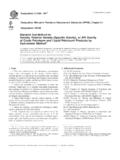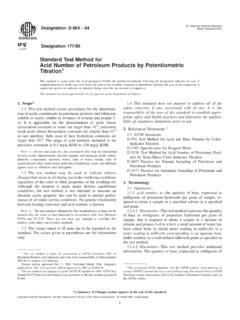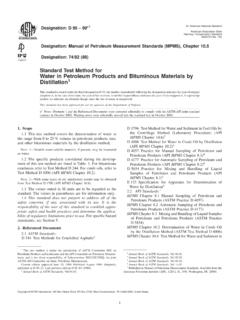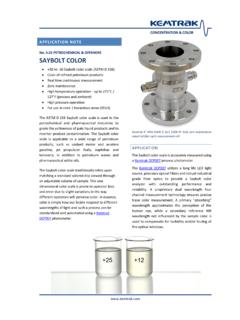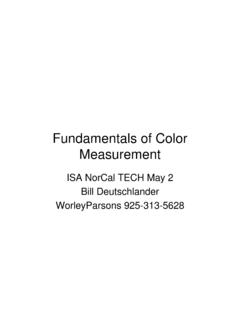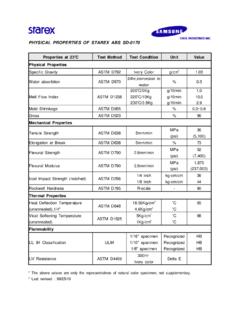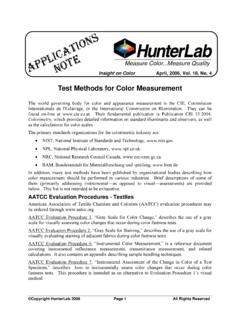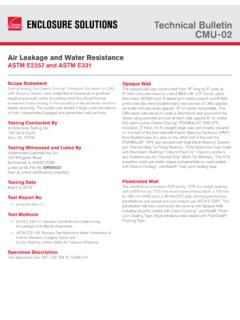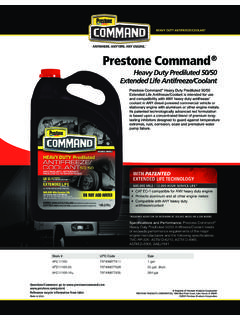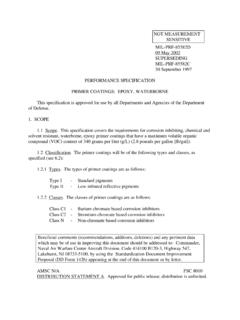Transcription of Standard Test Method for Base Number …
1 Designation: D 4739 02An American National StandardStandard Test Method forBase Number determination by potentiometric Titration1 This Standard is issued under the fixed designation D 4739; the Number immediately following the designation indicates the year oforiginal adoption or, in the case of revision, the year of last revision. A Number in parentheses indicates the year of last reapproval. Asuperscript epsilon (e) indicates an editorial change since the last revision or Scope* This test Method covers a procedure for the determina-tion of basic constituents in petroleum products and lubricants(Note 1). The test Method resolves these constituents intogroups having weak- base and strong- base ionization proper-ties, provided the dissociation constants of the more stronglybasic compounds are at least 1000 times that of the next This test Method covers base numbers up to 70. Whileit can be extended to higher base numbers, the precision of thetest Method for base numbers greater than 70 has not In new and used oils, the constituents which can be consid-ered to have basic properties are primarily organic and inorganic bases,including amino compounds, although certain salts of heavy metals, saltsof weak acids, basic salts of polyacidic compounds, and some additivessuch as inhibitors or detergents may show basic This test Method can be used to indicate relative changesthat occur in an oil during use under oxidizing or other serviceconditions regardless of the color or other properties of theresulting oil (Note 3).
2 Although the analysis is made underclosely specified conditions, the Method is not intended to, anddoes not, result in reported basic properties which can be usedunder all service conditions to predict performance of an oil;for example, no overall relationship is known between bearingcorrosion or the control of corrosive wear in the engine andbase Test Method D 4739 was developed as an alternative for theformer base Number portion of Test Method D 664. base numbersobtained by this Method may or may not be numerically the same as thoseobtained by the former base Number portion of Test Method D A color indicator titration Method is also available in the TestMethod D 974 and IP 139. The base numbers obtained by the potentio-metric Method may or may not be numerically the same as those obtainedby Test Method D 974 or equivalent color indicator methods such as givenin Federal Test Method Std. No. 791b. potentiometric methods for basenumber are also available in Test Method D The values stated in SI units are to be regarded as Standard does not purport to address all of thesafety concerns, if any, associated with its use.
3 It is theresponsibility of the user of this Standard to establish appro-priate safety and health practices and determine the applica-bility of regulatory limitations prior to Referenced Standards:D 664 Test Method for Acid Number of Petroleum Productsby potentiometric Titration3D 974 Test Method for Acid and base Number by Color-Indicator Titration3D 1193 Specification for Reagent Water4D 2896 Test Method for base Number of Petroleum Prod-ucts by potentiometric Perchloric Acid Standard :IP 139 Test Method for Acid Number by Color-IndicatorTitration Federal Test Method :Federal Test Method Standard No. 791b Lubricants LiquidFuels and Related Products; methods of Testing63. numbers,n the quantity of acid, expressed inmilligrams of potassium hydroxide per gram of sample that isrequired to titrate a sample, dissolved in a specified solvent toa specified end In this test Method , the sample istitrated to a meter reading corresponding to a freshly preparednonaqueous acidic buffer of Terms Specific to This base Number ,n the quantity of acid, ex-pressed in terms of the equivalent Number of milligrams of1 This test Method is under the jurisdiction of ASTM Committee D02 onPetroleum Products and Lubricants and is the direct responsibility of on Analysis of edition approved Dec.
4 10, 2002. Published February 2003. Originallyapproved in 1987. Last previous edition approve in 1996 as D 4739 base Number portion was last published in the 1981 Book of ASTM Standards, Vol Book of ASTM Standards, Vol Standards for Petroleum and Its Products, Part 1. methods for Analysis from Standardization Documents Order Desk, DODSSP, Bldg. 4,Section D, 700 Robbins Ave., Philadelphia, PA 19111-50981*A Summary of Changes section appears at the end of this ASTM International, 100 Barr Harbor Drive, PO Box C700, West Conshohocken, PA 19428-2959, United hydroxide per gram of sample, that is required totitrate a sample dissolved in the specified solvent from theinitial meter reading to a meter reading corresponding to afreshly prepared basic buffer Summary of Test The sample is dissolved in a mixture of toluene,propanol-2-ol (isopropyl alcohol), chloroform, and a smallamount of water and titrated potentiometrically with alcoholichydrochloric acid solution.
5 The test results of this procedureare obtained by titration mode of fixed increment and fixedtime additions of the titrant. An endpoint is selected from atitration curve according to the criteria given in and usedto calculate a base Significance and New and used petroleum products can contain basicconstituents that are present as additives or as degradationproducts formed during service. The relative amount of thesematerials can be determined by titrating with acids. The basenumber is a measure of the amount of basic substances in theoil always under the conditions of the test. The base numberis used as a guide in the quality control of lubricating oilformulations. It is also sometimes used as a measure oflubricant degradation in service. Any condemning limits mustbe empirically Titrimeter, automatic or manual, withcapability of adding fixed increments of titrant at fixed timeintervals (see Annex A1).
6 The titrimeter must automatically (or manually) con-trol the rate of addition of titrant as follows: Delivery of titrantwill be incremental; after delivery of precisely a (see ), the delivery is stopped and a fixed timeperiod of 90 s is allowed to pass before another of titrant is delivered. This procedure is repeateduntil the titration is The precision of addition of the incrementsof titrant must mL for automatic titrators. Formanual buret, it should mL. A higher incrementalprecision is required for an automatic buret because the totalvolume to the end point is summed from the individualincrements, whereas with a manual buret it is read from a Indicating Electrode, pH 0 to 14, general Electrode, Silver/Silver Chloride (Ag/AgCl)reference electrode, filled with1M-3 MLiCl in Certain alternative electrode-electrolyte combinations havebeen found to give satisfactory results although the precision using thesealternatives has not been determined.
7 Combination electrodes may be usedprovided they conform to and have a sufficient fast response , Buret, Stand, Titration Vessel, as specified inAnnex A1 are required. A typical cell assembly is shown in , Nonaqueous Acid Add 10 mL of buffer stocksolution A (see ) to 100 mL of titration solvent. Use , Nonaqueous base Add 10 mL of buffer stocksolution B (see ) to 100 mL of titration solvent. Use Stock Solution A Accurately weigh of 2,4,6-trimethyl pyridine (g-collidine), and transfer to a 1-Lvolumetric flask containing 100 mL of anhydrous isopropylalcohol. Using a 250-mL graduated cylinder, add to the flask,while continuously stirring its contents, 150 HCl solution (NHClbeing the exact molarity ofthe HCl solution found by standardization). Dilute to the1000-mL mark with anhydrous isopropyl alcohol, and mixthoroughly. Use within 2 Stock Solution B Accurately weigh and transfer to a 1-L volumetric flaskcontaining 100 mL of anhydrous isopropyl alcohol.
8 Using a250-mL graduated cylinder, add to the flask while continuouslystirring its contents, 50 KOHsolution. (NKOH being the exact molarity of the KOH solutionfound by standardization). Dilute to the 1000-mL mark withanhydrous isopropyl alcohol and mix thoroughly. Use within , reagent grade. (Warning Toxic and sus-pected carcinogen.) Acid Solution (Warning Causes severeburns. Recognized carcinogen. Strong oxidizer.) Acid Solution, Standard Alcoholic ( ) Mix 9 mL of reagent grade hydrochloric acid (HCl, sp ) (Warning Toxic and corrosive), with 1 L of anhydrousisopropyl alcohol. Standardize frequently enough to detectnormality changes of by potentiometric titration ofapproximately 8 mL (accurately measured) of the KOH solution diluted with 125 mL CO2-free Acid Solution, Standard Alcoholic ( ) Prepare and standardize as described in , but use 18mL of HCl (sp gr ) . Chloride Electrolyte Prepare a saturated solu-tion of lithium chloride (LiCl) in isopropyl 1 Cell for potentiometric TitrationD4739 ,NO2C6H4OH,(Warning Toxic),(mol weight ), conforming to the following require-ments:Melting point96 to 97 CColorPale Store the reagent in a brown glass Hydroxide Solution, Standard Alco-holic( ) Add6gofreagent grade potassium hydroxide(KOH) (Warning Toxic and corrosive), to approximately 1 Lof anhydrous isopropyl alcohol.
9 Boil gently for 10 min to effectsolution. Allow the solution to stand for 2 days and then filterthe supernatant liquid through a fine sintered-glass the solution in a chemically resistant bottle. Dispense ina manner such that the solution is protected from atmosphericcarbon dioxide (CO2) by means of a guard tube containingsoda lime or soda non-fibrous silicate absorbent (Ascarite,Carbosorb, or Indicarb), and such that it does not come intocontact with cork, rubber, or saponifiable stopcock frequently enough to detect normality changes by potentiometric titration of weighed quantities ofpotassium acid phthalate dissolved in CO2-free Hydroxide Solution, Standard Alcoholic( ) Prepare, store, and standardize as directed in ,but use 12 to 13 g of KOH to approximately 1 L of anhydrousisopropyl (Isopropyl Alcohol), Anhydrous, (lessthan % H2O) (Warning Flammable). If dry reagentcannot be procured, dry it by distillation through a multipleplate column, discarding the first 5 % of material distilling overand using the 95 % remaining.
10 Also, drying can be accom-plished using molecular sieves such as Linde Type 4A, bypassing the solvent upward through a molecular sieve columnusing 1 part of molecular sieve per 10 parts of solvent.(Warning It has been reported that, if not inhibited against it,propanol-2-ol can contain peroxides. When this occurs, anexplosive mixture is possible when the storage vessel or otherequipment such as a dispensing bottle, are near empty andapproaching dryness.) of Reagents Reagent-grade chemicals shall beused in all tests. Unless otherwise indicated, it is intended thatall reagents shall conform to the specifications of the Commit-tee on Analytical Reagents of the American Chemical Society,where such specifications are grades may beused, provided it is first ascertained that the reagent is ofsufficiently high purity to permit its use without lessening theaccuracy of the Commercially available solutions may be used inplace of laboratory preparations provided the solutions havebeen certified as Alternate volumes of solutions may be preparedprovided the final solution concentration is of Water Unless otherwise indicated, refer-ences to water shall be understood to mean reagent water asdefined by Type III of Specification D Solvent In a brown reagent bottle, add 30mL of water to 1 L of isopropyl alcohol and mix 1 L each of toluene and chloroform and mix , reagent grade.
